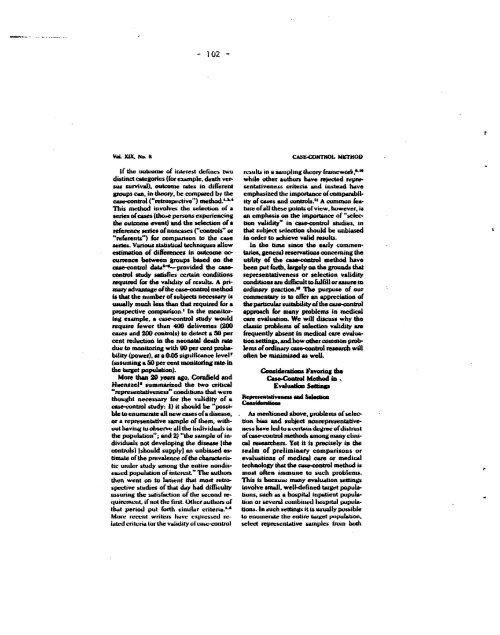BOOKS OF RtfiDIfGS - PAHO/WHO
BOOKS OF RtfiDIfGS - PAHO/WHO
BOOKS OF RtfiDIfGS - PAHO/WHO
Create successful ePaper yourself
Turn your PDF publications into a flip-book with our unique Google optimized e-Paper software.
VoL XIX. N. a<br />
- 102 -<br />
f tdie outeonie of interest delries two<br />
distinct categories (lfor exunple, death versus<br />
surival). outcome rates in different<br />
groups can, in theory, be compared by the<br />
case-ontrol ("retrospective") method." ' & '<br />
This method inivolves the election of a<br />
series of earso (btho~ persons experiencing<br />
the outo«me event) and the selection of a<br />
reference series ofnoncases ("onrols" or<br />
"referents") for comiparison to the case<br />
series. Vasious itaitica4l techniques allow<br />
estimion of differences in outiom occurrence<br />
between groups based on the<br />
cae-onatwl data'-provided the casecontrol<br />
study satisfies certain conditions<br />
requised for the validity of results. A primary<br />
advantage of the case-control method<br />
is that the number of subjects necessary is<br />
usually much les tan that required for a<br />
prospective comparison.' In the monitorlng<br />
exnple, a cas~o ntrol study would<br />
require fewer than 400 deliveries (200<br />
cases and 200 controls) to detect a 50 per<br />
cent reduction in the neonatal death rute<br />
due to monitoring with 90 per cent probability<br />
(power), at a 0.05 significance level t<br />
(assuming a 50 per cent monitoring rto in<br />
the target population).<br />
More than 20 yean ago. Cornfield and<br />
Haenszel' summrized the two critical<br />
represmntativeness' conditions that were<br />
thought necessary for the validity of a<br />
cse-control study: 1) it should be "possible<br />
to enumerate all new cases of a disease.<br />
or a representative sample of them, without<br />
haviig to doserve all the isdlviduals ¡i<br />
the population"; and 2) "the sample of individuals<br />
not developing the dierse ithe<br />
contrulsl Ishould supplyl an unbiased estimrte<br />
of the prevalence of the chtraceristic<br />
under study among the entire nondiseased<br />
population of interest. The authors<br />
then went un tu lamuint that most retrospective<br />
studies of dtit day had dificulty<br />
assuring the saislacwtion of the seond reqOtler authors of<br />
that period put forth simnilar criteria.u'<br />
More recent writers have cxpressed related<br />
criteria lor the validity oícal-cmotrol<br />
CASEV-COXNlTOL MTHOD<br />
resultl in a samplinig theory fraunework,?<br />
while other authors have rejected representativeness<br />
criteria and ilnstead have<br />
empha>sized the importance ofcompanbility<br />
ofcases and controls." A conimon feature<br />
of all these points of view. however. is<br />
un emphasis on the importance of "section<br />
validity" in casfcontrol studies, in<br />
that subject selection should be unbiased<br />
in order to achieve valid results.<br />
aIn the time since the early commentaries,<br />
genend resevatioa s onceming the<br />
utility of the caa.control method have<br />
been put forth, largely o the grouds that<br />
representativeness or selection validity<br />
conditions ar difficult to fulfll or auure in<br />
ordinary practice." Thbe purpose of our<br />
commentary is to offer an appreciation of<br />
the particular suitability of the case-control<br />
approach for many problems in medical<br />
cae evaluation. We will discuss why the<br />
clasic problems of selection validity are<br />
frequently absent in medical care evaluation<br />
settinr. and how odither common problemns<br />
ofordinary case-control resarch will<br />
often be miimizod as well.<br />
Coalidera~ Favorina the<br />
CaM-Cotil Method in .<br />
Evaluadon Sem~is<br />
bepresenaatveanrs ad Se~oo<br />
Co.sldodnlooe<br />
A menlioned above, problem of selection<br />
bias and subject nonrepresentativeness<br />
haive loed o a curin degree of dinstrus<br />
ofl s-control methods among many clinical<br />
researchers. Yet it is precisely in the<br />
realm of preliminary comparisons or<br />
evaluations of medical care or medicld<br />
teehnology tht the -control metdihod is<br />
most often immune to such problems.<br />
This is because many evaluation setting<br />
involve amall, well-defined turget populabions,<br />
such as a hospital inpatient population<br />
or several co¡nbsied hospital pupulations.<br />
In such settings it is usually possible<br />
to enuumeraite the entire target population.<br />
selecL representative wmlples froinm hud<br />
a

















